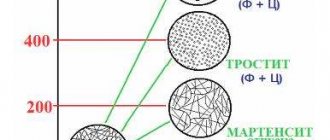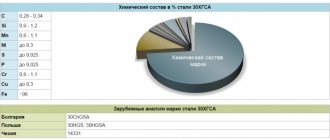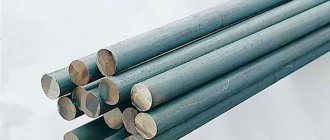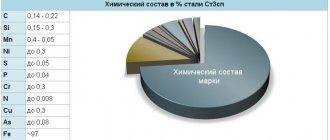The word “heat treatment” is not new to ordinary people. Everyone understands perfectly well why it is needed. Increasing the strength of steel. But why does this happen? What processes are occurring in the metal at this moment? Most shrug their shoulders. If you want to understand what heat treatment is, find out the difference between annealing and tempering, and why 45 steel is hardened in oil and not in water, then this article is for you.
Structural changes in metal
When heating special structural steel 45 to the austenitic level, the state of the structural lattice of iron changes with a transition from a body-centered to a face-centered structure. The carbon included in pearlite and representing the smallest crystals of Fe3C (cementite) moves into a face-centered modified iron lattice.
Structure of steel 45 after annealing and hardening
During cooling, the temperature of the steel being processed rapidly decreases, but due to the slowdown in the speed of movement of carbon atoms, they remain embedded in the new iron lattice, forming a solid supersaturated structure with internal stress. The lattice is transformed into a tetragonal lattice with orientation in one direction.
The formation of needle-shaped small structures called martensite occurs. This type of crystal gives the metal high strength, hardness and improved characteristics. Two types of austenite and martensite crystals are simultaneously formed, which act on each other, creating internal excess stress. When external forces actively influence the metal, mutual compensation of the two types of crystals occurs, imparting strength to the structure.
The essence of the process
The normalization procedure is as follows. The part is heated to temperatures that exceed the maximum permissible parameters (Ac1, Ac3) by 30 - 50 degrees Celsius, then it is kept at this temperature for some time, after which it is cooled.
The temperature is selected based on the steel grade. Thus, alloys containing 0.8% carbon, so-called hypereutectoid, are processed at temperatures lying between the critical points Ac1 and Ac3.
What are critical points? This is the name given to the temperatures at which phase changes and structure of the alloy occur when it is heated or cooled.
The result of this is that a certain volume of carbon enters the solid solution and austenite is fixed. That is, a structure consisting of martensite and cementite appears. It is cementite that leads to an increase in wear resistance and hardness. Heating high-carbon steel above ac3 leads to an increase in internal stresses. This is due to the fact that the amount of austenite increases due to an increase in carbon concentration.
When heated above the critical point Ac3, steel with a carbon content of less than 0.8% acquires increased viscosity. This happens because in steel of this type austenite (fine-grained) appears, turning into martensite (fine-grained).
Hypoeutectoid steel is not processed at temperatures in the range Ac1 - Ac3. Since in this case ferrite appears, which reduces the hardness parameters.
Time required to complete the operation
It takes some time to obtain a homogeneous structure of the alloy at a certain temperature. This time will be determined as the holding time of steel during normalization. It was experimentally determined that a layer of metal 25 mm thick becomes homogeneous after an hour. Thus. and determine the normalization time.
The final stage is cooling
The cooling rate plays a significant role in the formation of perlite volume and the size of its plates. Numerous studies have shown that high cooling rates increase the amount of perlite and the steel gains increased hardness and strength. Low cooling intensity leads to steel losing hardness and strength.
When processing parts with significant differences in size, for example. shafts, it is advisable to remove stresses arising under the influence of temperature fluctuations. To do this, they are preheated in a container filled with different salts. When the temperature drops, it is possible to speed up this process by placing hot parts in water or specially selected oil.
In other words, steel normalization eliminates stress inside the part and minimizes its structure. That is, it has a direct effect on changes in the microstructure of steel alloys.
Heat treatment of metal
To change the characteristics of steel, heat treatment is carried out in compliance with the necessary exposure modes.
The heat treatment process consists of the following processes:
- annealing;
- normalization;
- aging;
- hardening and tempering.
Heat treatment modes for steel 45
Hardening and tempering of steel largely depends on a number of factors:
- temperature conditions;
- rate of temperature increase;
- time period of exposure of metal to high temperatures;
- cooling process (rate of change in cooling temperature of a medium or liquid).
Normalization
The operation in question involves heating the steel and cooling it in the open air, which can result in crushing of the coarse-grained structure.
Unlike annealing, normalization improves viscosity and reliability several times. Such changes are noticeable upon cooling in air, which promotes the decomposition of austenite phases at low temperatures.
Perlite is translated from French as “pearl” and refers to a rock of volcanic origin.
After this, an increase in perlite occurs and this is one of the reasons for the improvement in mechanical features.
Steel hardening
The steel hardening process involves heat treatment of workpieces with heating to a temperature above critical with further acceleration of cooling. This condition helps to increase the strength and hardness (HRC) of steel while reducing ductility and improving consumer characteristics.
The mode of influence of the metal cooling temperature depends on the amount of carbon content and alloying additives in the steel.
After hardening the steel, the workpieces are covered with a coating of scale and partially lose the carbon they contain, so the technology must be followed in accordance with the established regulations.
Cooling of the metal must occur quickly to prevent the transformation of austenite into sorbitol or troostite. Cooling must be carried out exactly according to the schedule; rapid cooling of the workpieces leads to the formation of small cracks. During the cooling process from 200 °C to 300 °C, an artificial slowdown occurs as the products gradually cool down; for this, coolants can be used.
Hardening steel using HDTV
When carrying out surface hardening using high-frequency frequencies, the process of heating products is carried out to a higher temperature.
This is caused by two factors:
- Heating is carried out in a short time with accelerated change and transition of pearlite to austenite.
- The transition reaction must be carried out in a short time within a short period of time at high temperature.
Hardening with high-frequency currents
The processes occurring during conventional hardening in a furnace using high-frequency frequencies have different characteristics and lead to a change in the hardness (HRC) of the workpieces:
- When heated in an oven, the speed is 2-3 °C/sec up to 840 – 860 °C.
- Using HDTV - 250 °C/sec to a temperature of 880 - 920 °C or in mode at 500 °C/sec - up to 980 - and 1020 °C.
When using HDTV, parts are heated to a higher temperature, but the workpiece does not overheat. In the process of processing using HDF, the heating operation time is significantly reduced, which helps maintain grain size and structure. During the high-frequency hardening operation, the metal hardness (HRC) increases by 2-3 units. according to Rockwell.
Chemical composition
Anyone who deals with alloys knows that the elements that make up them affect their characteristics. Steel 45 is a high-quality structural carbon steel. From the name it becomes clear that it contains carbon - 0.45%. The majority, of course, is iron – 97%. The remaining 2.55% includes such chemical elements as manganese (0.7%), silicon (0.2-0.3%), nickel (0.25%), chromium (0.25%), copper (0.25%), arsenic (0.08), sulfur (0.04) and phosphorus (0.035%). Each of the alloying elements affects the characteristics of steel 45. For example, manganese is present in almost all grades of steel. It removes oxygen from it and reduces the sulfur content. Silicon affects the hardenability of steel. In addition, it increases the yield and elastic strength.
Application of protective measures
During the heat treatment process, carbon gradually burns out and scale forms. To prevent deterioration of the quality of the metal and protect it, shielding gases are used, which are pumped during the hardening process. Ammonia or methane gas is pumped into the furnace, which has a sealed chamber, where heat treatment occurs using a special generator.
In the absence of sealed furnaces, processing operations are carried out in a special sealed container, into which cast iron shavings are first poured to prevent carbon burnout.
When processing workpieces in salt baths, the metal is protected from oxidation, and to create the necessary conditions for maintaining the carbon level, the contents of the bath are deoxidized 2 times during the day with boric acid, blood salt or borax. At processing temperatures in the temperature range of 760-1000 °C, charcoal can be used as a deoxidizing agent.
Annealing
The annealing procedure includes heating, holding and long cooling in the furnace. There are two types of the process under consideration, which we have presented in detail in the tabular version below.
| Genus species | Tasks | Peculiarities |
| first | evens out the chemical composition of the metal increases the processing of steel using pressure reduces residual stress after processing | Its structure does not undergo transformation and remains unchanged for any task, t=500-630°C |
| second | grinding metal grains helps form the ferrite+pearlite structure | This type is preparatory heat treatment. It is used to improve the machinability of steel, t=770-840°C |
Use of special coolants
During the technological process, water is mainly used to cool parts. The quality of the coolant can be changed by adding soda or special salts, which can affect the cooling process of the workpiece.
To preserve the hardening process, it is strictly forbidden to use the water contained in it for extraneous operations. The water must be clean and have a temperature of 20 to 30 °C. It is forbidden to use running water to harden steel.
Composition of mixtures of salts and alkalis used as quenching media
This hardening method is used only for cemented products or those with a simple shape.
Products with complex shapes made from special structural steel are cooled in a 5% caustic soda solution at a temperature of 50-60 °C. The hardening operation is carried out in a room equipped with exhaust ventilation. Mineral oils are used to harden workpieces made of high-alloy steel, and the cooling rate in an oil bath does not depend on the oil temperature. Mixing oil and water is unacceptable, as this can lead to cracks in the metal.
When quenching in an oil bath, a number of rules must be followed:
- Be careful not to ignite the oil.
- When the metal cools in the oil, harmful gases are released (exhaust ventilation is required).
- Plaque forms on the metal.
- Oil loses its properties when intensively used to cool metal.
When carrying out the hardening process of steel 45, it is necessary to follow the technological process in compliance with all operations.
Recommendations when choosing
65g steel cannot be welded at all. When manufacturing products, this property should be taken into account.
You also need to remember that the material is most often used for sports edged weapons. This is due to good impact resistance at the simultaneous low cost of the starting material. This allows you to have shells available at low material costs.
Knife made of 65G steel.
Knives made from 65g are not recommended for use for household purposes, for example, in the kitchen, where there is constant dampness. To prevent cutting tools made from this grade from rusting, they must be stored in dry rooms. The oil coating will protect the blades from corrosion.
Steel tempering 45
The technological process of steel tempering is carried out depending on the required temperature:
- in ovens with forced air circulation;
- in special baths with saltpeter solution;
- in oil baths;
- in baths filled with molten alkali.
The temperature for the tempering process depends on the grade of steel, and the process itself changes the structure and helps reduce the stress of the metal, and the hardness decreases by a small amount. After all operations, the workpiece is subjected to technical control and sent to the customer.
When hardening and tempering metal at home, it is necessary to strictly observe the technology and safety precautions for carrying out work.










